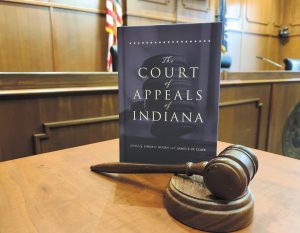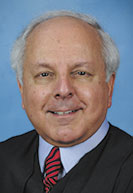Subscriber Benefit
As a subscriber you can listen to articles at work, in the car, or while you work out. Subscribe Now
When the Court of Appeals of Indiana was established in 1891, the Legislature intended for the new judicial intermediary bench to exist for just six years.
The Indiana Supreme Court was overwhelmed with cases, so a lower appellate court was created to preside over mundane matters, such as cases for recovery of less than $1,000 and appeals of misdemeanors. However, with the justices still overloaded two years later, the General Assembly expanded the jurisdiction of the Court of Appeals to include appeals from the trial courts, and then in 1901, the appellate court was made permanent.
A new book documents the history of Indiana’s Court of Appeals by telling the story through the men and women who have served as judges.
Just published this spring, the book, “The Court of Appeals of Indiana,” is a compilation of profiles of the roughly 120 judges who have sat on the appellate bench through its 131-year history.
Court of Appeals Judge Edward Najam Jr., who spearheaded the book project, explained the opinions and rulings issued from the appellate bench are a reflection of the life experiences and legal thinking of the individuals who wore the robes.
“Every day, lawyers and judges cite cases from the Court of Appeals, and these cases all have authors, but many of them, particularly the judges in the distant past, we don’t know very much about, except we’re familiar with their names,” Najam said. “(The book) was a way of informing the bar and the public and the trial bench, these are the people who wrote the opinions that we’re still writing about, that we’re still citing.”
The release of the book coincides with the celebration of the 50th anniversary of the Indiana constitutional amendment that came into existence on Jan. 1, 1972, and made the Court of Appeals a constitutional court. Since then, the appellate judges have been selected by the governor rather than through partisan elections.

Najam tapped the team that had pulled together a similar biographical compilation, “Justices of the Indiana Supreme Court,” to work on the Court of Appeals book.
Elizabeth Osborn, director of education at the Indiana University Center on Representative Government, reprised her role as project director and helped design and define the steps for crafting the book. Also, the husband-and-wife editorial team of James St. Clair and Linda Gugin returned as editors, working closely with the authors and polishing the drafts.
Early in the process, Najam and Osborn connected with Indiana Historical Society Press, which published the book.
The tome covers every Hoosier appellate jurist from James B. Black, Jeptha New, Milton Robinson, George Reinhard and Edgar Crumpacker, who all became the first judges starting in March 1891, to Leanna Weissmann, who took a seat on the court Sept. 14, 2020.
Unfortunately, the court’s newest member, Judge Derek Molter, is not part of the book because he joined the court Oct. 1, 2021, after the book was mostly completed.
“I’m looking forward to having this book placed in libraries so that people can consult with it,” Najam said. “… This shows a remarkable diversity of backgrounds and experiences.”



All rise
Gugin and St. Clair instructed the authors to focus on the personal. The editors wanted 750-word vignettes that provided the color of the judges’ childhoods, journeys to the law, families and daily lives. They asked for candid stories that highlighted the different experiences and perspectives of each judge without glorifying the individuals.
While the authors could include information on the rulings their judges had issued, Gugin and St. Clair set the limit at one or two opinions so the legal work would not overshadow the personalities.
“We were trying to get the authors to write about them in a way that people could see these are human beings that are making these decisions,” Gugin said. “They have a variety of backgrounds that they bring to the court and to their decisions.”
Among the reveals are that Judge Allen Sharp, serving on the appellate court from 1969 to 1973, did not like his middle name and never used it, or even his middle initial. Also, Judge Robert Staton (1971-2000) was one of the “dedicated practitioners and a fervent devotee” of calligraphy, while Judge John Ryan (1959-1964) roomed with the son of Chicago gangster Al Capone during his freshman year at Notre Dame.
To find these details, the lawyers, professors, historians, archivists, professors, judges and justices who wrote the biographies dug through newspapers, law review articles, books, directories and sometimes interviewed relatives or colleagues. St. Clair, a former reporter, was able to sniff out obscure sources whenever an author had trouble finding materials.
In addition, Gugin and St. Clair noted they could always rely on current Court of Appeals court administrator Larry Morris. When they had questions about court rules, appellate history and the judges, Morris had the answers.
“There was nothing he didn’t know about the Court of Appeals,” Gugin said. “I would call him and the next day or so, he would have an answer for me. … He was so helpful.”
‘Work in progress’
The first judges on the Court of Appeals were all white men, and those demographics remained unchanged for 87 years until Judge V. Sue Shields became the first woman appointed to the Indiana appellate bench in 1978. Thirteen years later, Judge Robert Rucker became the first African American on the Court of Appeals in 1991.
“I think my appointment does mean a lot of things to a lot of different people — male, female, Black and white,” Rucker said at the time. “And I hope that the appointment can serve as a beacon of inspiration to our children, certainly to other African American lawyers and to the legal community in general.”
Nine women have followed Shields onto the Court of Appeals bench, seven of whom are still serving. Judge Elaine Brown’s appointment in 2008 created the first all-female appellate district with Judges Margret Robb and Nancy Vaidik.
Since Rucker, Judges Carr Darden and Rudolph Pyle III are the only other African Americans to have been seated on the Court of Appeals.
“I think the terms of gender and race, they’re a work in progress,” Gugin said of the Court of Appeals. “… We need to keep making progress.”
The book was launched May 3 at the Indiana State Bar Association’s “Evening with the Appellate Judges.” As part of the reception and dinner in downtown Indianapolis, the hardbound book was given to all the guests.
Now, the Court of Appeals is working to craft a book tour by scheduling events with local bar associations and taking copies along when the judges travel for Appeals on Wheels oral arguments. The appellate bench is hoping the summer offers the opportunity to reconnect with lawyers and jurists around the state and to share some fun stories.
Najam said he is confident the book’s outline of the Court of Appeals’ history and the biographical profiles will bring a better understanding of the appellate process in Indiana to both lawyers and nonlawyers alike.
“I find the book very interesting reading,” Najam said. “… I’ve served with 32 judges since I’ve been on the court and in reading this book, I learned many things about some of them that I had not known before.”•
Please enable JavaScript to view this content.
